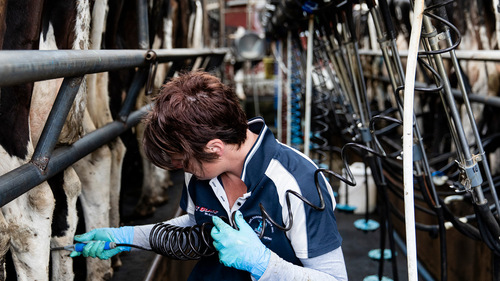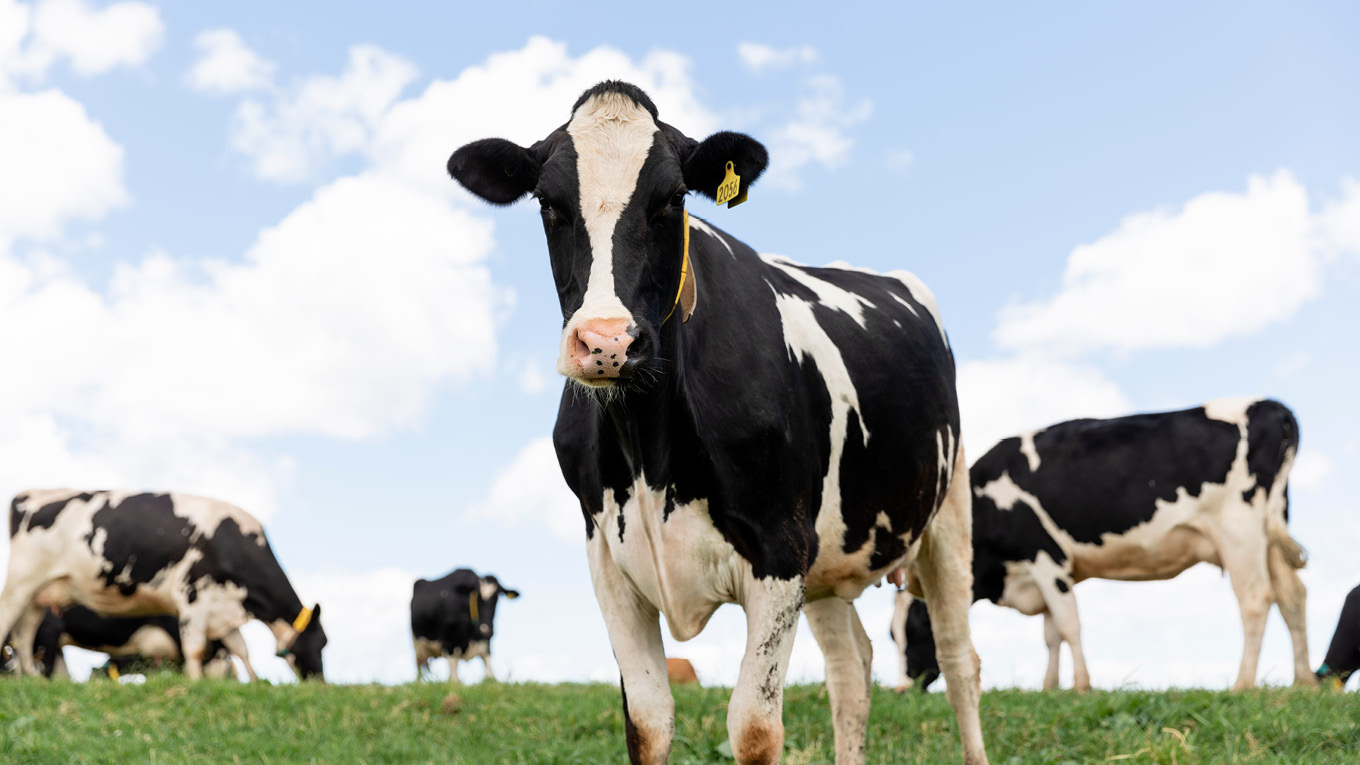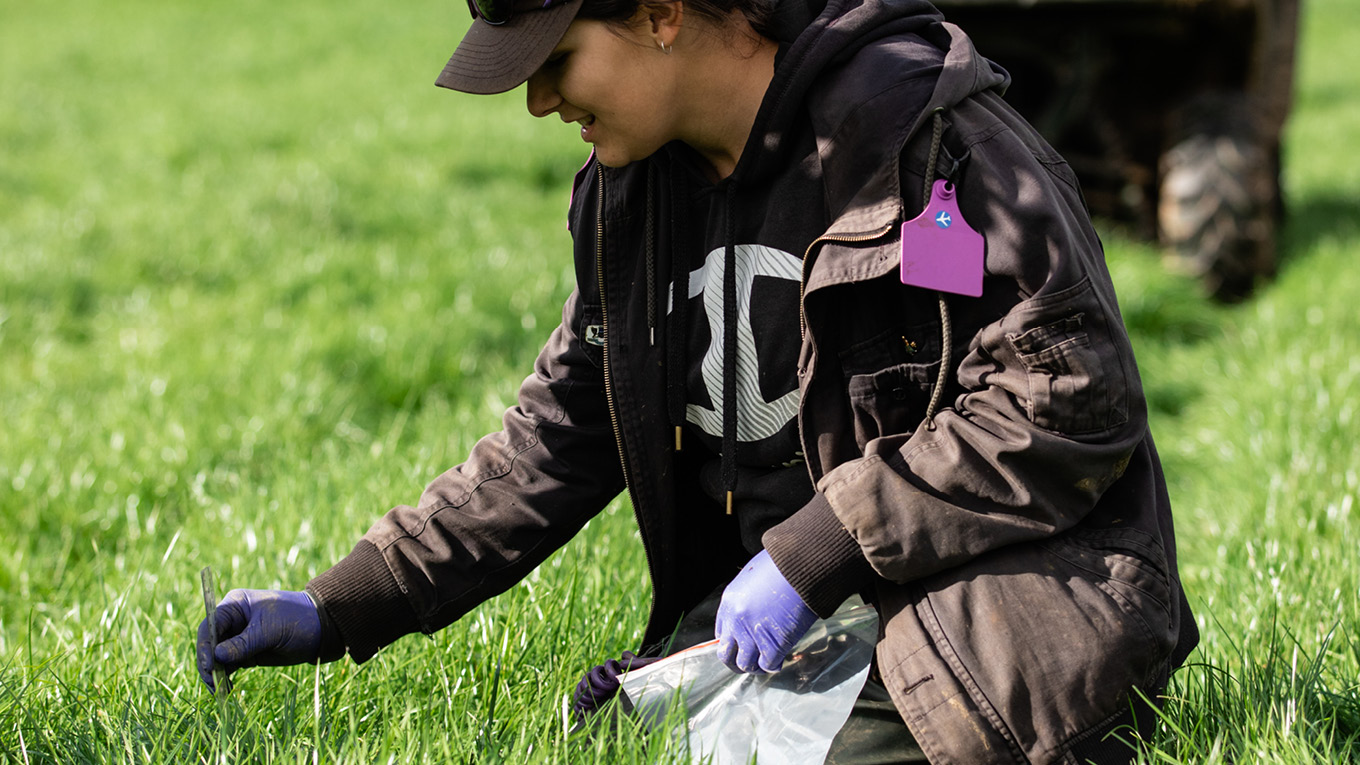Milking Plant Hygiene
Poor milking plant hygiene can reduce milk quality which therefore impacts milk pricing and dairy farm profitability.
Some tips on maintaining good milking plant hygiene are provided below.
Dairy cleaning practices
Many dairy farmers have moved from hot water sanitising to chemical sanitising, especially in Gippsland and Western Victoria, where approximately 50% of farmers now use a chemical sanitiser at least once a day, according to a study funded by Dairy Australia.
If not managed carefully, this can pose a risk to market access. Farmers need to be aware that unless chemical sanitisers are rinsed thoroughly from the plant before the next milking, traces of the chemical can be left on the pipework.
Although all of the chemical sanitisers being used in dairies have been evaluated for safety, this does not stop international customers and regulators putting their own requirements on the products that they wish to purchase.
For example, some markets are very sensitive to residues of quaternary ammonium compounds or benzalkonium chloride, contained in some dairy sanitisers.
This means some dairy companies are working with their farmer suppliers to minimise the risk of residues in their milk supply. Depending on the milk company, some farmers may be asked to review their dairy cleaning practices.
Frequently asked questions - use of QACs on farms
-
What is a QAC?
Quaternary ammonium compounds (QACs) are a group of chemicals widely used as biocides and disinfectants in the home, industry and in food manufacture. Products containing QACs are used to clean and sanitise the milking machine and/or vat on some dairy farms. Benzalkonium chloride (BAC) is the specific type of QAC of most interest and is present in a number of products registered for use on dairy farms. -
Do I need to change my current practices? Why?
Some international customers have placed strict requirements on the level of BAC residues they are prepared to accept in the products they import. Consequently, some milk companies are requiring their suppliers to change the way they currently use QAC-based dairy sanitisers to ensure these high-value markets remain open to them. -
How do I know if the dairy chemicals I am using contain QACs?
QACs are used to kill (sanitise) bacteria in the milking machine and vat. They are found in a number of products registered for use on dairy farms. If the product contains QACs, one of the following active constituents will on the front panel of the product label:
- BENZALKONIUM CHLORIDE
- QUATERNARY AMMONIUM COMPOUND
- N-ALKYL DIMETHYL BENZYL AMMONIUM CHLORIDE
An indicative list of products registered with the Australian Pesticides and Veterinary Medicines Authority (APVMA) is available under the 'Products registered with the APVMA' section below.
-
What do I do if my wash program is automated?
Changes to automated wash controllers should be done in association with the company supplying the controller. Dairy chemical advisors should be able to assist with these changes too. -
What alternatives do I have to change my current cleaning practices to minimise QAC residues?
There are three main options to minimise the risk of QAC residues:
- Rinse the sanitiser out after use
- Use hot water in place of a sanitiser
- Change the type of chemical used to sanitise the milking machine and/or vat.
The most appropriate option will depend on the farm's situation and on the milk company's requirements, which may vary. A decision tree has been created to help farmers work through the various options in association with their milk company or dairy detergent adviser.
Decision tree – do you use a chemical sanitiser in your vat or milking machine cleaning program?
Option 1. Rinse out QAC-based sanitisers
How soon should I rinse out the plant after QAC use?
QAC-based sanitisers only need a few minutes to do their work, so can be rinsed from the plant immediately after their use, or preferably immediately prior to the next milking. Warm or cold water should be used at the same volume as used for the sanitising rinse.
Good-quality water is needed to avoid re-introducing bacteria into the milking machine or vat. Milking equipment should be well-drained so minimal water is collected with the next milk.
Option 2. Use hot water to sanitise the plant instead
How hot does the hot water need to be?
Water needs to be at or above pasteurisation temperature at every point in the pipework for at least 20 seconds to effectively sanitise the pipework. This means the hot water temperature in the wash barrel should be at between 90 and 93 degrees Celsius as it enters the milking plant. Use the same volume as used for the other detergent and sanitising cycles. Hot water is unsuitable for sanitising vats.
Option 3. Use an alternative chemical to sanitise the plant instead
What other sanitising chemicals are available?
There are many registered dairy sanitiser products available that do not contain QACs. Alternative chemicals may not suit the water quality, so the decision to change over needs to be taken together with a dairy chemical adviser.
Some alternative chemicals also need to be rinsed out after use to avoid other residue issues, but there are some acid-based sanitisers that have been approved by the APVMA to be left in the plant to drain.
-
Are the alternative chemicals more expensive?
The total cost of cleaning and sanitising the milking machine and vat each day are largely determined by the costs of heating water (power costs) and the cost of the chemical. Although a drum of an alternative chemical may cost more than a drum of QAC-based chemical, in many circumstances the total costs (power and chemical) of using an alternative chemical will be similar or less than either rinsing out the QAC-based sanitiser or using hot water to sanitise the plant instead. -
What do I do with any leftover QAC chemical?
If the decision is made to stop using QAC-based sanitisers, leftover chemical should not be returned to the place of purchase, stored or disposed of on-farm. Existing product should be used according to the current wash program, ensuring it is thoroughly rinsed from the plant after use. This may mean some delay before the new cleaning program can be implemented.
House-keeping tips – Milking machine and vat hygiene
Wash program and chemical use
- Review the milking machine and vat wash program to ensure it still meets the programs recommended by the equipment manufacturer or dairy chemical adviser.
- Check/measure the volume of water used in each cycle of the wash program and whether it complies with the wash program.
- Check the solution temperature of each cycle and whether it matches the program.
- Check automatic chemical dosing pumps or manual chemical measuring procedures to ensure the correct volume of chemical is being used at each wash cycle.
- Double-check whether the volume of chemical calculated equates with the volume of chemical being purchased over a given period of time.
Hygiene observations
- Review the source of water used for cleaning the milking machine and vat. Is a better quality water available, requiring less chemical to achieve the same result?
- Review milk quality results, looking at Bactoscan/total plate count and thermoduric counts over time. Are these indicators well within target ranges?
- Check plant cleanliness. Are the milk contact surfaces clean? Check inside the bowl of the clusters furthest away from the receiver. Inside of the receiver and milk lines are also good places to check for deposits.
- Does the plant require frequent 'bomb' treatments to remain hygienic? If so, your routine cleaning program needs improvement.
Minimising residues
- Ensure the milking machine and vat drain completely after every cleaning. Cleaning solutions trapped in the pipework compromise hygiene and reduce milk quality at the next milking. Drainage issues may need investigating with a milking machine technician.
- Check and follow the label directions of dairy cleaning chemicals, particularly rinsing chemical sanitisers from the plant prior to the next milking.
- Consult with a dairy chemical adviser to choose dairy cleaning chemicals that have a low risk of residues. Some customers are very sensitive to particular cleaning chemicals
Products registered with the APVMA
Products registered with the APVMA containing QACs as an active constituent as at 15 July 2013
This list is indicative only. There may be other dairy cleanser products containing QACs that are no longer registered as they are being phased out, or products that contain QACs as an ingredient, but not an active constituent. For more information, talk to a dairy detergent adviser.
| APVMA No | Company name | Product Name | Actives |
| 52522 | ADVANCE CHEMICALS | ADVANCE WERTHEIM TWIN CLEAN LOW FOAMING ACID DETERGENT SANITISER | BENZALKONIUM CHLORIDE / PHOSPHORIC ACID / SULFAMIC ACID / SULFURIC ACID |
| 52566 |
AGVANTAGE PTY LTD / CATTLEKARE | EXCEL ACID PLUS ACID MILKSTONE REMOVER | PHOSPHORIC ACID / QUATERNARY AMMONIUM COMPOUND |
| 30030 | DASCO | KLEER X LIQUID ACID DETERGENT | PHOSPHORIC ACID / QUATERNARY AMMONIUM COMPOUND |
| 53876 | DASCO | MULTI-TEMP ACID DAIRY DETERGENT SANITIZER | BENZALKONIUM CHLORIDE / PHOSPHORIC ACID / SULFAMIC ACID / SULFURIC ACID |
| 60692 | DELAVAL | DELAVAL ACIDET ACID MILKING MACHINE AND BULK MILK TANK DETERGENT SANITISER | GLYCOLIC ACID / PHOSPHORIC ACID / QUATERNARY AMMONIUM COMPOUND |
| 65106 | ECOLAB | DAIRY POWER ALKASAN ALKALINE DAIRY DETERGENT & SANITISER | GLYCOLIC ACID / PHOSPHORIC ACID / QUATERNARY AMMONIUM COMPOUND |
| 51288 | ECOLAB | DAIRY POWER FLEXI-TEMP ACID DAIRY DETERGENT & SANITISER | BENZALKONIUM CHLORIDE / GLYCOLIC ACID / ORTHO PHOSPHORIC ACID |
| 49188 | ECOLAB | DAIRY POWER HYSAN ALKALINE DAIRY DETERGENT & SANITISER | BENZALKONIUM CHLORIDE / SODIUM CARBONATE / SODIUM TRIPOLYPHOSPHATE |
| 45901 | ECOLAB | KLENZ-ALLTEMP ACID DETERGENT SANITISER | BENZALKONIUM CHLORIDE / PHOSPHORIC ACID / SULFAMIC ACID / SULFURIC ACID |
| 52986 | MILESTONE CHEMICALS | MILESTONE DAIRY CLEANING SYSTEMS DAIRY PROOF | ALKALINE SALTS / QUATERNARY AMMONIUM COMPOUND |
| 51152 |
RUAKURA | SANIKLENZ LOW FOAMING ACID DETERGENT SANITIZER | BENZALKONIUM CHLORIDE / PHOSPHORIC ACID / SULFURIC ACID |
| 45318 | TASMAN CHEMICALS | TANK AID PLUS BULK TANK CLEANER ACID SANITISER | BENZALKONIUM CHLORIDE / PHOSPHORIC ACID |
| 55486 | TASMAN CHEMICALS | THERMOFLUSH MULTI ACID DAIRY DETERGENT SANITISER | GLYCOLIC ACID / PHOSPHORIC ACID / QUATERNARY AMMONIUM CHLORIDE |
| 30205 | TRENT VALLEY / QUALCHEM | DIA-SAN DAIRY SANITISER | N-ALKYL DIMETHYL BENZYL AMMONIUM CHLORIDE |
| 30000 | TRENT VALLEY / QUALCHEM | DUPLEX MULTI-PURPOSE ACID DAIRY DETERGENT SANITISER | BENZALKONIUM CHLORIDE / SULFAMIC ACID |


